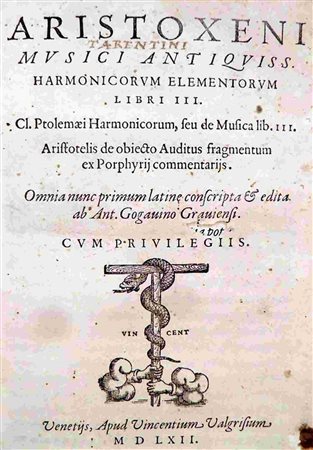 Bertolami Fine Art - Sendlinger Straße 24, 80331 Monaco
Bertolami Fine Art - Sendlinger Straße 24, 80331 Monaco
WEB AUCTION 118 - LIBRI E AUTOGRAFI WEB AUCTION 118 - LIBRI E AUTOGRAFI
Thursday 16 June 2022 hours 14:00 (UTC +01:00)
ARISTOXENUS OF TARENTUM (C.375-322 BC); CLAUDIUS PTOLEMAEUS (C. 100- 160 CE): Aristoxeni musici antiquiss. Harmonicorum Elementorum libri III. Cl. Ptolomaei Hormonicorum, seu de Musica libri III. Aris
ARISTOXENUS OF TARENTUM (C.375-322 BC); CLAUDIUS PTOLEMAEUS (C. 100- 160 CE)
Aristoxeni musici antiquiss. Harmonicorum Elementorum libri III. Cl. Ptolomaei Hormonicorum, seu de Musica libri III. Aristotelis de obiecto auditus fragmentum ex Porphyrij commentarijs. Omnia nunc primum latine conscripta & edita ab Ant. Gogavino Graviensi. Venetijs, apud Vincentium Valgrisium, 1562
§ 4to, 165, [3] pp.; sign.: A-X4 (leaf X4 blank). Woodcut diagrams throughout Ptolemy’s work (pp. 47-150). Tables for the ratios of enharmonic, chromatic and diatonic scales at pp. 112-114, for octave species (σχῆμα τοῦ διὰ πασῶν) and intervals at pp. 102-106, 116-123. An excerpt from a work by Porphyry of Tyre, not listed in the title page, can be found at pp. 161-165 (De decem praedicamentis liber, seu potius pars libri de Praedicabilibus). Each work except the first one has its own half-title page (pp. 47, 151, 161); printer’s device repeated on leaf X3v. Contemporary full brown calf binding. Nice and clean copy with the upper margin slightly short.
Extremely scarce and sought-after first Latin edition of the two most ancient surviving treatise on ancient Greek musical theory. Aristoxenus himself endeavoured to describe the musical system in all its coherence and complexity, setting out from the simplest of entities (musical sound) and proceeding to increasingly complex combinations of intervals and ‘systems’, envisaged simultaneously according to their ‘range’, ‘disposition’ and ‘function’. The last part of the treatise is a set of theorems setting out the laws of harmonics.
Ref Adams A 1973; Eitner IV, 298; Fétis I, 137; A. Barker (ed.), Greek Musical Writings, II. Harmonic and Acoustic Theory, pp. 119-189, 270-391; S. Gibson, Aristoxenus of Tarentum and the Birth of Musicology; A. Barker, Scientific Method in Ptolemy’s “Harmonics”.





